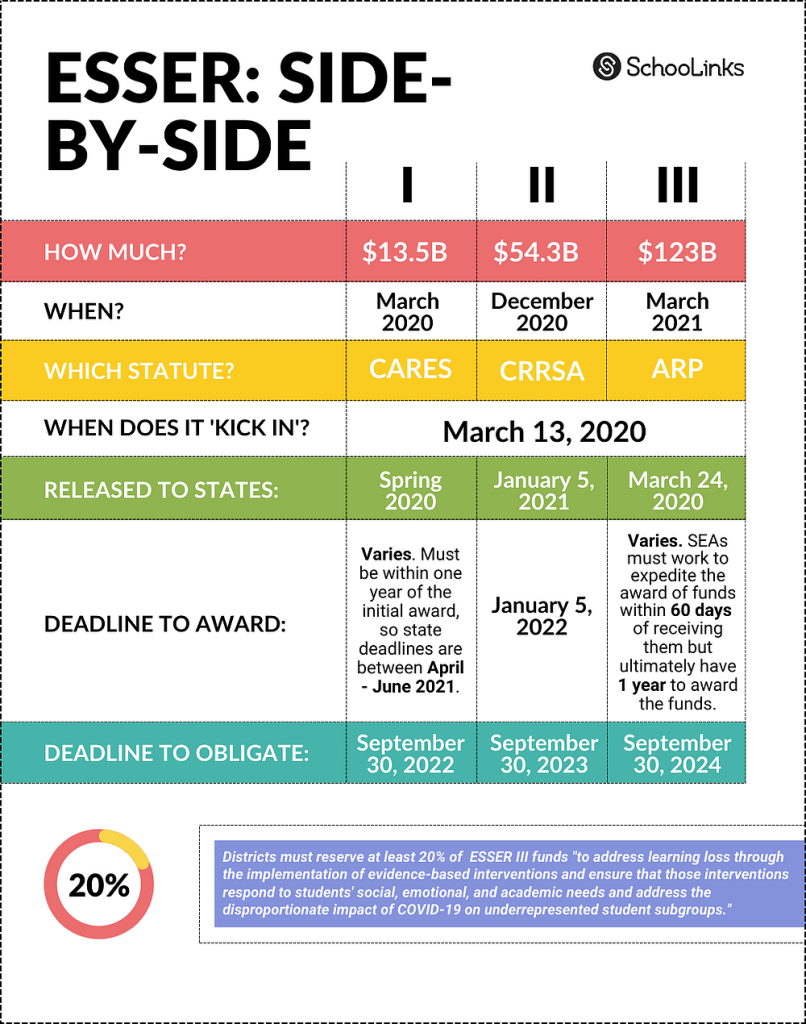The Elementary and Secondary School Emergency Relief (ESSER) Funds are three phases of funding which were created as part of various Coronavirus relief packages over the past few years. In total they come to a bit more than $190B. But in spite of the high dollar amount, school districts are struggling to spend it.
As that article highlights, there are a lot of reasons for the struggle. The money is a one time grant and increasing the amount spent on salary would be difficult to keep paying once the money runs out (although this is a completely allowable use of funds), buying EdTech might not always help students, and as always, the paperwork attached to so much money is a headache, and something a lot of these schools haven’t had to deal with before.

In an attempt to kickstart spending, some of which expires on September 30th, 2022, the Whitehouse has released a Fact Sheet on how to spend your ESSER money to best “support student success”.
The Fact Sheet conveniently divides the recommendations into three categories:
- Summer programs
- Tutoring
- Afterschool programs
First, they cite two studies which prove that high quality summer learning programs are ways to help students “gain” learning, but it has also long been known that “summer learning loss” affects lower income students at a higher rate than middle or high income students. Since learning loss in general has been so pronounced because of COVID, any sort of learning reinforcement is a good idea. Knowing where to start can be challenging, but the National Summer Learning Association and Discover Summer has a number of resources that can help people out.
As for high quality tutoring, and especially the kind of mentorship, adult interest, and connection that comes along with it, have shown impressive results, just as the fact sheet says. A lot of the fact sheet is dedicated to tutoring, and finding tutor volunteers in one form or another, but the focus is on “high quality tutoring” or sometimes called “high dosage tutoring”. Unfortunately this does not include the more common “commodity” tutoring companies like Paper, which optimizes for cost and I was told, wants students to keep the strong mentorship bond with the teacher and not with the tutors. High dosage tutoring is hard, but the Whitehouse is advocating for a less “off the shelf” solution and something more driven by in person community efforts.
And afterschool programs have a similar profile to summer learning programs. It is the kind of “outside the classroom” learning that was already being done for more well off kids, but was missing for kids in the lower or middle incomes. Creating more options ad stronger options also gives parents, especially parents whose work isn’t as likely to be WFH, more scheduling options and reduces stress on older siblings to try to take care of younger siblings.
It is still uncertain if these recommendations will galvanize spending in the way that the Biden Administration is hoping, but it would be wonderful to hear of an expansion of evidence based programs for all these areas.
More Stories
Tutoring as a part of teaching / Everything comes back to money
One of the difficult things with education is our reliance on a “one size fits all” model. We have for...
Justin Reich on Learning Loss, Subtraction in Action, and a future with much more disrupted schooling
Justin Reich is an education and technology researcher and the director of MIT’s Teaching Systems Lab. He hosts a podcast...
Public K-12 Enrollment is falling and that is dangerous and exciting
A surprising result of COVID and the resulting school closures is that many parents, after struggling to figure out how...
Esports could help re-diversify a shrunken curriculum
Esports and schools feel like a pretty strange fit. Regular sports have always gone with schools, but adding esports still...
Review of “How to Raise Successful People” by Esther Wojcicki
This is an interesting book with the perspective of a unique person that ultimately falters because of the blind spots...
SIGGRAPH at 50
SIGGRAPH , the premier conference on computer graphics education, held its 50th event last week in Los Angeles. Back in...
